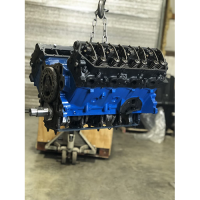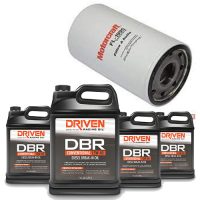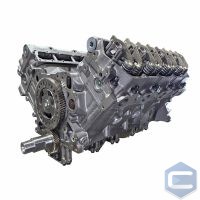Current Lead Times: In Stock Engines Ship Same or Next Day - Out of Stock: 1-3 Weeks on Most Long Block Engines; 3-5 Days on Heads – *call us for more exact lead times for your specific build
Manufacturer: CHOATE Engineering Performance. CHOATE Part Number :CEP73LCE
Fitment : Fits 1994-2003 Ford 7.3L Powerstroke Equipped Vehicles
Designed to last. Built and engineered to fix the factory flaws, as well as exceed the lifecycle of the original engine from Ford.
The Ford 7.3L Powerstroke platform has been a solid one for the F-series truck owners. Interestingly enough, the International/Navistar engine that was sold to Ford for their trucks, was a collaboration between International and Caterpillar. Caterpillar designed the “HEUI” injection system. Or a hydraulically actuated, electronically controlled, unit injector. The engine is known as the T444E in the International sector. This is because it is direct injected, turbocharged with 444 cubic inches of displacement and electronic, unlike its predessor, the IDI 7.3.Which was indirect injected. The failures of the 7.3L Ford Powerstroke engine in the 99-03 are exclusive to Ford. You typically won’t see this failure in an International Truck. There is a good reason as to why. That’s because the airbox of the 7.3L Ford Powerstroke F-Series Truck uses an inferior box that doesn’t seal properly. Once more, it only seals worse when an aftermarket air filter is added. This in turn has led to many Ford 7.3L Powerstroke Engines being replaced because of low compression. Dirt is allowed to escape past the filter and into the engine, where it is trapped between the rings and cylinder wall. This will damage both the rings, and the wall and allow what is known as “blow by.” This condition is where the compression gasses pass the rings, and enter the crankcase. This causes the vapors to be pushed out of the oil filler neck you often see in videos.
Once this has taken place the only recourse is to pull the engine, and then send it out to be machined. The cylinders would have to be taken to the next appropriate size piston that would allow them to clean up the damage. It’s the little things that make big differences. Rarely will you ever hear me advocate for an aftermarket filter. But in the case of the 7.3L, I don’t know that there is a more cost effective return on investment than this. A simple matter like replacing the stock filter, literally will save you the cost of an engine. That being said, you will often notice that the 94.5-97 engines “last longer” and it has nothing to do with the engine. It does however, have everything to do with the filtration system.
This dirt also is what causes so many issues with the valve guides wearing prematurely. And dirt getting between the valve and seat exacerbates the wear of the valve face and makes the valve margin become razor thin! (See Photo Below)
Most of the engine builders will reuse valves. Grinding them, creating a new surface for the valve face to seal against the seat. The issue however, is that by grinding a valve past its margin, means there is less material for heat dissipation. Eighty percent of the heat absorbed into the valve is dissipated through the seat. That means it is absolutely critical that there is enough material for the valve to endure the heat cycle. If there isn’t the valve will crack, this in turn, at best causes low compression. At worst, will break off and drop into the cylinder. The rest is history. The engine at that point is done, and must be overhauled. So you can see just how simple one dimension can drastically change the longevity and performance of the engine. There are good reasons why we at Choate Engineering Performance build engines a certain way. Any Choate Engineering Performance Engine you buy, is engineered to outlast the competition. The approach to each platform is very specific! We start at what we call the CIA. That is the best source of information. That acronynm means, concern, inspect, analyze. Our engineering starts with the failure and works backwards. Just like the valve failure, it’s not enough to simply look at the failure and see the effect. The cause is the greatest concern, because that is the first step to resolution.
The 7.3L powerstroke engine doesn’t suffer from many problems. Because it is the HEUI system, it saves itself. The real acronym for HEUI is “helping engines against uneducated installers.” While that is a bit tongue and cheek, there is a lot of truth to it. The fact that the engine needs high pressure oil to fire the injectors means that it cannot run without oil. I have literally seen guys have enoromous oil leaks and run the truck until it gets so low on oil it can’t fire the injectors. Then, coast to the side of the road, pour more oil in and keep going. We had a customer refuse to pay a tow bill, and at the caution of us, decided it much better to just drive it. But the time he got to our shop he had lost 3 gallons of oil. Not a great idea, certainly it causes wear to the low pressure oil pump as well as other components. But, it won’t typically lock up an engine as a high pressure common rail would do.
The true fix is to fix the cause, (the faulty air filter) and fix the effects. Which is the worn valve guides, and valves. There are some major upgrades we are able to do with the material in the valves we use now, verse the OE.
There is something we else that needs to be considered when purchasing a 7.3L Powerstroke engine. And that is, only a small few remanufacturers will actually replace the factory seat. The original seat is integrated into the cylinder head. It is induction hardened to insure that the seat will not wear causing the valve to sink farther and decrease the lash. Most will “cut new seats” and install the valves. That isn’t ideal. You are cutting away the hardness of the seat, as the induction hardening process only penetrates the material so much. Along with that, the induction process can encourage cracks over numerous heat cycles. The crack has the potential to continue to run until it typically meets a hole. Most often a glow plug, or injector, possibly another valve. This isn’t the best choice for fixing the cylinder heads. You expect at the very least, no less than your factory OE Ford 7.3 Powerstroke Engine gave you. But by reducing this hardness, you are getting less than what you had before. That is why Choate installs a hardened 4Nseat that can withstand temperatures up to 1600 degrees. This has better wear characteristics than that of the parent material.
Keeping it straight is as critical if not more than all the other items. We mentioned the failures of the guide wear. The guide is a crucial portion of the valvetrain. It’s literally what keeps the valve straight and maintains the concentricity of the valve face to the valve seat. If there is “runout” then the valve will never close against the seat properly. This will lead to combustion gas loss, pressure drop in the cylinder, which is everything you need to force the piston back down the bore. Transferring the thermal energy into mechanical energy. The better the seal, the more of the pressure that gets excerted in the direction you need. But not only that, if there is a leak, it can act like a cutting torch over time. This intense heat that is escaping between the two surfaces will erode whichever is softest, or exceeds its structural integrity first.
Imagine taking an air hose and blowing a rubber tipped nozzle through your thumb and finger. I don’t suggest this, by the way. But if you know, well you know. Burns doesn’t it? Yeah, don’t do that anymore! But that’s a decent example of the leak that takes place between the two surface. Now imagine these gasses are 1300 degrees. It’s not an environment that is condusive to a long living valve and seat. That is why concentricity matters. Now, the factory tolerances for the guides were built amazingly loose! The Ford 7.3L Powerstroke Engine tolerances according AERA the trusted source for information concerning all things ICE, can be as high as .005 of an inch, which is the max allowable tolerance. It isn’t something we suggest running, and typically run .002-.0025. While that may not seem like a large number, when compared to the Ford 6.7L Powerstroke Diesel Engine, it exceeds it by sixty percent! No one ever said the 7.3L was a tight engine. Which leads to another point of why you can run the heavier weight 15w-40 oils that your grandpas tractor does. At any rate, the guide is cast into cylinder head. And there are better materials as well as process that will help make the engine live longer. Choate Engineering uses a iron matrix guide to accomplish this. Again, it isn’t just about the part. It’s also about the installation that makes the result worth doing. We all know that the cylinder walls are cross hatched for oil retention. Without this the rings would wear at a rapid rate, and it also wouldn’t seal properly. The guides are similar in that they can benefit from honing them once installed. This cross hatching serves the same purpose, lubricating the valve stem and providing a film of protection for the guide.
All this started out with a dirty air filter. It’s kind of surprising how the “little foxes spoil the vines”but it really can cost you a lot of unnecessary money, if you will just take care of the small things while they are small.
When it’s all said and done, the Ford/Navistar/International engine is a very forgiving and solid platform. You can get away with things you wouldn’t dream about in the modern diesel. For these reasons, it makes a lot of sense to many truck owners to keep these engines alive and going for millions of more miles. The dependability and the cost savings in repair and maintenace have no doubt earned their place in our diesel sooted souls.


